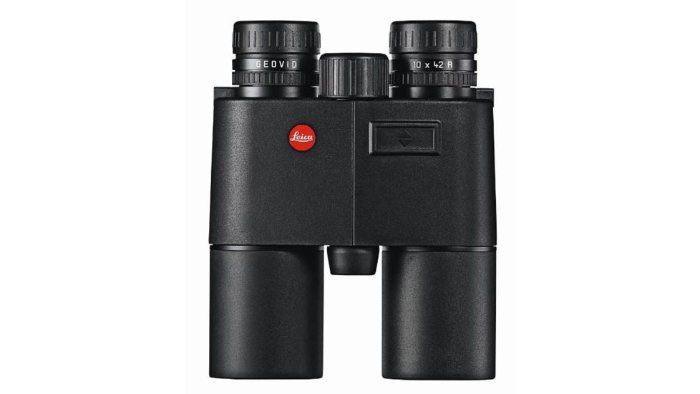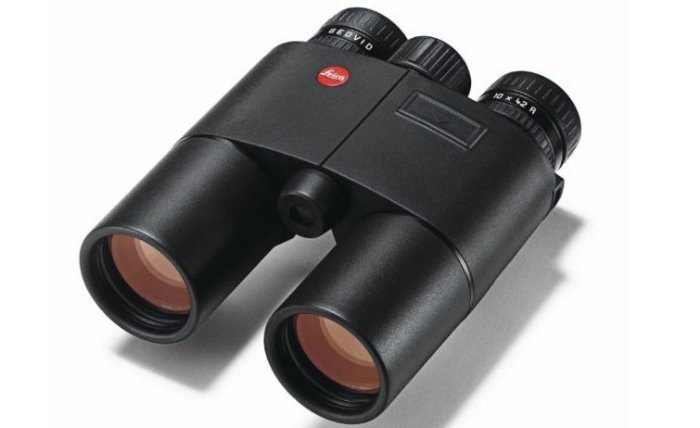We all know Leica as a high-performance and expensive brand.
Even so, the Geovid R series of binocular rangefinders are designed to be scaled-down versions of their high-end alternatives.
So, if you’re looking to own a Leica, this may be your chance. You’ll still need a generous budget though.
Quick Overview...
What We Like: Rangefinder binoculars
What We Don’t Like: Price
Best Uses: Bow Hunting, Rifle Hunting, Target Shooting, Wildlife Observation, Tactical Use
- Yard Range: 10-1200
- Magnification: 10x
- Objective Lens: 42mm
- Display Type: LED
- Dimensions: 4.9 x 6.6 x 2.8”/33.3 oz
- Waterproof/Fogproof: Yes/Yes
- Angle Compensation: Yes

Our Verdict: Though not as feature-packed or long-ranging as the Leica Geovid 3200.COM, it also doesn’t have the same price tag. If you want the ability to have a laser rangefinder in your binoculars while acquiring easy operation and a low-ish price, the Geovid R is a must-have.
Who is the Leica Geovid R 10X42 Best Suited to?
Leica puts the focus back into the essentials, that is, fast and accurate ranging, high-quality optics, and a comfortable-to-use binocular setup.
There are multiple manufacturers that offer the bino plus rangefinder combo, but when Leica has a scaled-down version available at competing price points with the competition, you will want the Leica over the others.
With ranging out to 1200 yards, angle compensation out to 600 yards, and dependable, accurate, and well-built algorithms, housing, and stereoscopic vision, it’s best suited to die-hard hunters and even some law enforcement agents.
How Does the Leica Geovid R 10X42 Perform?
The Geovid R is an aluminum binocular rangefinder with complete rubber armor over the entire housing and deep, recessed thumb rests. The 2-position eyecups are made of plastic, are detachable, and offer long eye relief of 20mm.
The optical diopter is located on the left eyepiece as the right eyepiece focuses for the rangefinder display. The central focus has fine and slow focusing so that you can experience what Leica optics is really about.
Needless to say, optical performance is excellent and will be especially impressive for those who have not yet owned a Leica. All air-to-glass surfaces are fully multi-coated, and the objective lens has their HDC (Highly Durable Coating) that helps to enhance light transmission while providing a scratch-resistant surface.
As far as rangefinding performance, actual accuracy in the field comes in at around .5-meter accuracy. Leica provides fast, instantaneous readouts, and with one-button operation, it’s so easy to employ during the hunt. While the R series have EHR technology, it does not have ballistic software.
All in all, the Geovid R binocular rangefinder proves itself as a high-end optic that puts the focus back on the essentials.
Features & Benefits

Rangefinder Binoculars
There are ordinary binoculars and ordinary rangefinders. What is extraordinary? Binocular rangefinders or rangefinder binoculars – whatever floats your boat.
These types of laser rangefinders are the most expensive and high-end versions of rangefinders available. Your digital riflescope may have a built-in rangefinder mode, but it’s stadiametric. Rarely ever does a scope have laser-acquired rangefinding for precision accuracy unless it’s the Pulsar Digisight Ultra LRF, and that costs a pretty penny too.
In other words, devices such as the Geovid-R are only worth considering if you want the benefits of two optical technologies in one device, have the budget to afford it, and want the best binocular engineering from the best brands. You get a brand-name, high-end binocular and rangefinder in one. It’s a kill-two-birds-with-one-stone kind of scenario.
With as high-performing, lightweight, and compact binoculars and laser rangefinders are these days, you may be better off with buying them separately. It really is user preference at this price point.
EHR Function
Yes, all rangefinders should have line of sight (true horizontal distance) as the standard measuring mode. Of course, the Geovid has this and scan mode. But the added feature is the EHR (Equivalent Horizontal Range) or what is mostly otherwise known as angle compensation.
While you can learn about angle compensation here, EHR on the Geovid only operates out to 600 yards. This is not unusual for any rangefinding device to provide limited angle compensation at a specific distance. If you’re in steep terrain and atop ridges where angles matter, you’re not taking shots beyond 600 yards anyway.
Speaking of ranges, this set has 10-1200-yard performance on highly reflective targets. It’s “soft and medium” target range will be less than 1200 yards.
Leica provides accuracy specs as follows: -/+ 1 yard accuracy up to 382 yards, -/+ 2 yard accuracy up to 766 yards, and -/+ 0.5% accuracy beyond 766 yards.
LED Display
If an illuminated reticle can make a big difference in making a well-placed shot, then an illuminated reticle in a laser rangefinder/binocular can make a big difference in ensuring you get to make that well-placed shot.
If you’re going to have a ranging bino combo, you may as well have an LED display and a reticle that you can see to allow for tight target distance acquisition.
The LED system is ambient sensitive, so the brightness of the display will change as needed as light conditions change. This ensures that you have the right amount of brightness at any given time during operation.
One Measuring System

Have you ever accidentally switched back and forth between yards and meters? Hardly ever do you need both measuring systems, so Leica did away with both and came out with rangefinders that only provide one type of measuring system.
In order to get either meters or yards, you must pay special attention to the model number of the Geovid R. The 40-427 is the meter version and the 40-428 is the yard version.
Size
So, it’s not a compact laser rangefinder – it’s a binocular that married laser rangefinding electronics. It’s not going to be as small as the Bushnell Prime 1300. To best appreciate it’s size, it must be put up against binoculars.
Providing a 10x42 platform, the Geovid-R weighs in at 33.3 ounces with the battery installed and is no longer than 6.6” and wider than 4.9”. It’s within standard size for rangefinder binoculars and actually weighs in at 10x42 bino weights (without rangefinding) that used to be the industry standard.
As far as weatherproofing is concerned, it’s completely waterproof – scratch that. It’s submersible to 16.5 feet in water, so torture tests and rainy days, here you come. Don’t worry about internal fogging, it’s nitrogen-filled.
Limitations
Price
Since when does Leica do anything the cheap way? It wouldn’t be a Leica if it were too cheap.
Put simply, you’re paying more for the Leica brand. It’s not just the name you’re buying, it’s the guaranteed quality that comes with it. It may not have the ranging power on deer that both more expensive and cheaper alternatives may have, but it really comes down to the fact that cheaper alternatives can’t actually acquire those crazy numbers anyway.
If we’re to be fair, the price isn’t ridiculous for an optic of this type. It falls more in line with competing prices between Vortex and Bushnell. It actually comes in cheaper than Zeiss or Swarovski.
Leica keeps it real with their specs. The glass quality is stellar. The laser technology is accurate. What more could you ask from a rangefinder? Oh, high-powered stereoscopic vision too. Wait, they did that.
Popular Questions
Leica has a manufacturing facility in Portugal, and as all their laser-integrated optics come from this facility, the Geovid R binocular is made in Portugal.
The Geovid R comes with a contoured neoprene carry strap, lens and eyepiece caps, Cordura case, user manual, and even a signed quality control card.
The laser rangefinding display is seen through the right eyepiece. The diopter allows for focusing the display for your vision.
The laser rangefinding button is located on the left side of the bridge of the binoculars. You will be activating laser operation via the left hand.
Leica has a special stabilizing tripod adapter that allows for mounting the Geovid to a Tripod. It’s essentially a baseplate with elastic rubber belts that hold the binocular in place while the baseplate is threaded onto the receiving end of any standard camera and field tripod.
Conclusion
The Geovid R might not have all the fixing’s that it could have, given that it’s a Leica optic, but it does have a lot more in the essentials than what competing brands can provide.
While you can still balk at the price, it’s not out of the ballpark for what most would pay for rangefinding binoculars.
The quality behind Leica products is best suited to both hunters and even LEOs (law enforcement officers). Hence, the Geovid R is a highly recommended buy.
Further Reading
- 10x42 vs 8x42 Binoculars for Hunting, Birding, Safari & Event Observation
- 4 Features to Consider & Look for When Buying Binoculars
- Best Binocular Magnification For Hunting, Birding, Wildlife Observation & More
- Binocular Glass 101: BK7 vs BAK4 and Porro Prism vs Roof Prism
- Binocular Terminology: Glossary Of Features & Parts Of Binoculars




